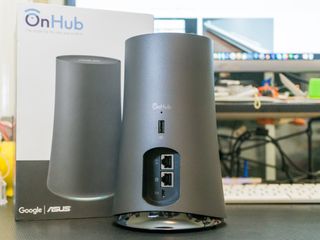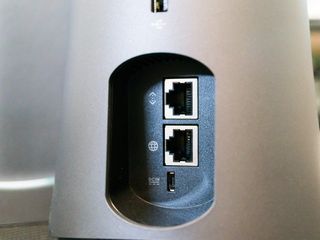My first day with OnHub didn't go well

I finally got around to looking at the ASUS OnHub router. Google wasn't lying when they say it's better looking than the Sputnik-inspired dual-band router with multiple external antennas and plenty of blinking things that I'm using now. I could see me putting this on the end table, where it would provide better reception in my house than it would tucked in the corner, behind the printer in my office. My wife wouldn't have any complaints, either. It looks more like a vase or a piece of fancy modern art than it does a network appliance. Good job, ASUS, Google and anyone else who helped design and build the thing.
But here we are, a day later, and I'm not using it.
In fact, I never even really got to try it, and that's because it only comes with one LAN port. Let me explain.
The single LAN port is a Gigabit ethernet jack, so anything you plug into it should have plenty of bandwidth in both directions. The issue is that there is only one of them. I need more. In my living room, I have a "smart" television, a networked A/V receiver, a PlayStation 4, a Shield TV, a Philips Hue hub and a Steam Box. I have an old switch I bought at an auction and have ran a Cat 6 cable from the office to the wall behind our entertainment center. Some of this equipment can use Wifi, but some can't. I wasn't looking for Wifi connectivity when I bought it, because I had a cable and a bunch of places to plug stuff into to get it on the Internet.
If you have a complicated home network, OnHub isn't going to be plug and play
In my office, I have the computer I work from every day, a printer, an old TV with a Nexus Player attached, a minature server farm in the closet, and some nerdy aquarium controllers and Raspberry Pi gadgets all connected to yet another second-hand network switch. Again, some of this has Wifi built in, while other parts don't. It was no big deal, because any router/wireless AP has a handful of LAN ports on the back. Or at least they used to.
Yes, things are more complicated here than they need to be. That's a common theme when I start geeking out and turning on electronic things. But in the end, I had to pull out the credit card and spend money at Amazon to try and find a way to get everything connected with only one LAN port. I might even have to run another cable. I'll know more when I try and put everything together. It will be fun. there will probably be beer.

I realize that my mess isn't the way the average consumer does things, and I am definitely not the target audience for Google's simple networking appliance. But I also know that tech enthusiasts like myself are very interested in what Google is doing with the OnHub routers, and we are the type of people who may have a not-so-simple home network already in place. I don't fault Google here. They never claimed that the router is suitable for a more "advanced" (read: patched together by tape and bailing twine) network environment. I'm just letting everyone know that if you have a similar mess of cables and switches and hubs (oh my!) strewn around your home, OnHub isn't going to be plug and play.
Be an expert in 5 minutes
Get the latest news from Android Central, your trusted companion in the world of Android
I'm going to have fun playing with new network toys and wires, and I look forward to using my OnHub router. I probably needed to get everything into the twenty-first century anyway. This is just a situation I never thought of (even though the specs clearly say there is only one LAN port) and I wasn't prepared. Be sure you are prepared if one ethernet plug isn't going to work for you, either.

Jerry is an amateur woodworker and struggling shade tree mechanic. There's nothing he can't take apart, but many things he can't reassemble. You'll find him writing and speaking his loud opinion on Android Central and occasionally on Twitter.
